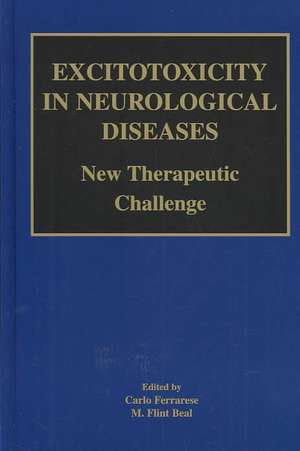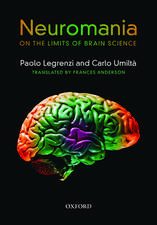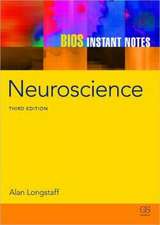Excitotoxicity in Neurological Diseases: New Therapeutic Challenge
Editat de Carlo Ferrarese, M. Flint Bealen Limba Engleză Hardback – 30 dec 2003
| Toate formatele și edițiile | Preț | Express |
|---|---|---|
| Paperback (1) | 948.47 lei 6-8 săpt. | |
| Springer Us – 16 oct 2012 | 948.47 lei 6-8 săpt. | |
| Hardback (1) | 956.18 lei 6-8 săpt. | |
| Springer Us – 30 dec 2003 | 956.18 lei 6-8 săpt. |
Preț: 956.18 lei
Preț vechi: 1166.08 lei
-18% Nou
Puncte Express: 1434
Preț estimativ în valută:
182.99€ • 198.70$ • 153.71£
182.99€ • 198.70$ • 153.71£
Carte tipărită la comandă
Livrare economică 23 aprilie-07 mai
Preluare comenzi: 021 569.72.76
Specificații
ISBN-13: 9781402076800
ISBN-10: 1402076800
Pagini: 380
Ilustrații: XI, 362 p.
Dimensiuni: 155 x 235 x 26 mm
Greutate: 0.75 kg
Ediția:2004
Editura: Springer Us
Colecția Springer
Locul publicării:New York, NY, United States
ISBN-10: 1402076800
Pagini: 380
Ilustrații: XI, 362 p.
Dimensiuni: 155 x 235 x 26 mm
Greutate: 0.75 kg
Ediția:2004
Editura: Springer Us
Colecția Springer
Locul publicării:New York, NY, United States
Public țintă
Professional/practitionerDescriere
It can be reasonably anticipated that, over the next generations, the proportion of elderly people will remarkably increase and, with this, the number ofpersons suffering from acute (e.g. cerebral ischemia) or chronic neurodegenerative disorders. To date, approved drugs only alleviate the symptoms ofthese diseases (for instance, acetylcholinesterase inhibitors in Alzheimer disease and L-dopa and dopamine-agonists in Parkinson disease), while none seems to stop the progression of the degenerative processes underlying them. The development of effective preventive or protective therapies has been impeded by the limitations of our knowledge of the causes and the mechanisms by which neurons die in neurodegenerative disorders. Evidence accumulated in the past 20 years indicated that the major excitatory neurotransmitter glutamate may play a role as neurotoxin in several conditions. In particular, the glutamatergic system dysfunction seems to be an early event working as a common pathway in the pathogenesis ofa large number ofacute and chronic neurological disorders, in strict conjunction with other important mechanisms, such as oxidative stress and energetic failure, and probably triggered by different mechanisms in various diseases. In consideration of that, drug discovery efforts over the last decade have been focused on the search for drugs that either reduce glutamate synaptic levels or block its postsynaptic effects. Despite numerous reviews on basic mechanisms and clinical aspects ofthe excitotoxic phenomenon, so far no comprehensive book has covered the topic in all its complexity, starting from basic pharmacological mechanisms, to .animal models of diseases and finally to clinical pathogenic and therapeutic implications.
Cuprins
and historical notes.- I: Basic mechanisms.- 1. Contribution of astrocyte glutamate release to excitotoxicity.- 2. Glutamate uptake and transporters.- 3. NMDA receptors.- 4. AMPA receptor and synaptic plasticity.- 5. Metabotropic glutamate receptors and neurodegeneration.- 6. Mechanisms of excitotoxicity and excitoprotection.- II: Acute and chronic neurological disorders.- 7. Epilepsy and seizures: excitotoxicity or excitotrophicity?.- 8. Excitotoxicity in cerebral ischemia.- 9. Excitotoxicity and traumatic brain injury.- 10. Excitotoxicity in amyotrophic lateral sclerosis: selective vulnerability of motor neurons.- 11. Glutamate transmission in the pathogenesis of Parkinson’s disease.- 12. Excitotoxicity in Huntington’s Disease.- 13. The glutamatergic system in Alzheimer’s disease brain: dysfunction associated with amyloid ?-peptide and oxidative stress.- 14. Neurotoxicity and prion disease.- 15. Glutamate excitotoxicity in multiple sclerosis.- 16. HIV-1 associated dementia.- 17. Markers of excitotoxicity in patients: tool for diagnosis or therapy?.- 18. Anti-excitotoxic therapies in neurological diseases: current evidences and new perspectives.













